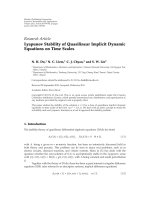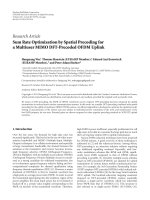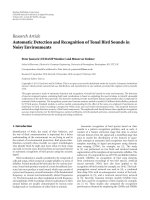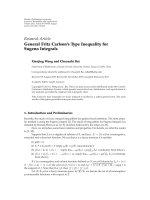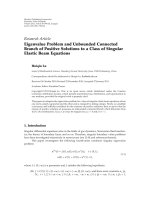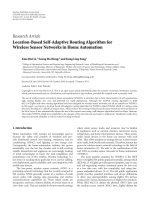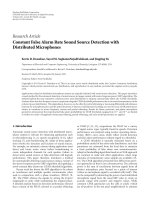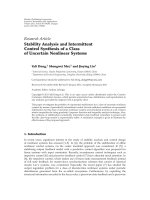Báo cáo hóa học: "Research Article Fully Decentralized and Collaborative Multilateration Primitives for Uniquely Localizing WSNs" doc
Bạn đang xem bản rút gọn của tài liệu. Xem và tải ngay bản đầy đủ của tài liệu tại đây (846.38 KB, 7 trang )
Hindawi Publishing Corporation
EURASIP Journal on Wireless Communications and Networking
Volume 2010, Article ID 605658, 7 pages
doi:10.1155/2010/605658
Research Article
Fully Decentralized and Collaborat ive Multilaterat ion Primitives
for Uniquely Localizing WSNs
Arda Cakiroglu
1
and Cesim Erten
2
1
Computer Science and Engineering, Is¸ık University, Sile 34980, Turkey
2
Computer Engineering, Kadir Has University, Istanbul 34083, Turkey
Correspondence should be addressed to Cesim Erten,
Received 31 August 2009; Accepted 21 September 2009
Academic Editor: Benyuan Liu
Copyright © 2010 A. Cakiroglu and C. Erten. This is an open access article distributed under the Creative Commons Attribution
License, which permits unrestricted use, distribution, and reproduction in any medium, provided the original work is properly
cited.
We provide primitives for uniquely localizing WSN nodes. The goal is to maximize the number of uniquely localized nodes
assuming a fully decentralized model of computation. Each node constructs a cluster of its own and applies unique localization
primitives on it. These primitives are based on constructing a special order for multilaterating the nodes within the cluster. The
proposed primitives are fully collaborative and thus the number of iterations required to compute the localization is fewer than
that of the conventional iterative multilateration approaches. This further limits the messaging requirements. With relatively small
clusters and iteration counts, we can localize almost all the uniquely localizable nodes.
1. Introduction
Many applications and systems from areas such as environ-
ment and habitat monitoring, weather forecast, and health
applications require use of many sensor nodes organized as
a network collectively gathering useful data; see [1]fora
survey. In such applications it is usually necessary to know
the actual locations of the sensors. Sensor network local-
ization is the problem of assigning geographic coordinates
to each sensor node in a given network. Although Global
Positioning System (GPS) can determine the geographic
coordinates of an object, a GPS device has to have at least
four lines of sight communication lines between different
satellites in order to locate itself. Thus, in cluttered space
or indoor environments GPS may be ineffective. Additional
disadvantages including the power consumption, cost, and
size limitations allow only a small portion of nodes in a large
scale sensor network having GPS capabilities. It is important
to design methods that achieve localization with limited
use of such systems. A common paradigm introduced to
overcome this difficulty is the iterative multilateration where
only a small portion of the nodes are assumed to be anchor
nodes with a priori location information. Every node uses
its ranging sensors to measure distances to the neighbors
and shares the measurement and location information if
available. Multilateration techniques are then employed in
an iterative manner to collectively estimate node locations
from such information [2]. Assuming no measurement
errors, “unique” localization of a sensor node is achieved via
trilateration from three anchor positions if distance to those
anchors is known. Although this is a sufficient condition for
uniqueness, it is rarely necessary in wireless sensor networks
settings. A finite number of possible locations for a set of
neighbor nodes for which range information is available may
also provide unique location for a sensor node. In this paper
we propose primitives for unique localization of nodes in a
sensor network. Assuming measurements with no noise, the
goal is to maximize the number of uniquely localized nodes
employing iterative multilateration. The proposed primitives
are fully decentralized, fully collaborative. The suggested
collaboration model gives rise to a high rate of unique
localization. Moreover, this is achieved with reasonably low
energy requirements for message exchanges as the average
number of iterations per node is low.
2 EURASIP Journal on Wireless Communications and Networking
2. Related Work
We can classify the previous work based on where the
computation takes place and the type of localization solution
produced. Centralized methods assume the availability of
global information about the network at a central computer
where the computation takes place [3–5]. Whereas in
decentralized methods each node usually processes some
local information gathered via a limited number of message
exchanges [6, 7]. A second distinction between different
methods is the localization output produced. In unique
localization a single position is assigned to each node in the
network [8]. Even though the topology of the underlying
graph may not give rise to a unique localization, it may still be
possible to assign a finite set of positions for each node, called
finite localization [4]. There has been recent interest and
theoretical results on uniquely localizing networks. However,
the suggested methods usually rely on centralized models
[4]. To overcome this difficulty, cluster-based approaches or
collaborative multilateration have been suggested. Moore et
al. propose the idea of localizing clusters where each cluster
is constructed using two-hop ranging information [7]. Only
trilateration is employed as the localization primitive which
results in fewer nodes being uniquely localized as compared
to the primitives we propose. Savvides et al. propose n-
hop collaborative multilateration. The nodes organize into
collaborative subtrees, then using simple geometric relation-
ships each node constructs a position estimate and finally
the estimate is refined using a least-squares method. The col-
laboration is on sharing distance and position information
within n-hops but each node is still responsible for locating
itself. With our model of full collaboration, not only does
a node receive information to compute its position but it
may also receive information regarding its own location from
neighboring nodes as well.
3. Unique Localization Primitives
Our unique network localization method relies on two low
level primitives: Reliable internode distance measurement
and internode communication mechanisms. Several tech-
niques such as TDoA, RSSI, ToA may be used to obtain
distance between two sensor nodes [9, 10]. The gathered
distance information is assumed to be error-free. We also
assume that the communication between sensor nodes is
through broadcasting and that the broadcasted data is
received by all neighboring nodes within the sensing range
of the broadcaster.
The main unit of localization is a cluster.Eachnode
u in the sensor network
N goes through an initial setup
phase constructing C
r
u
, the r-radius cluster centered at u.
Let N
u
denote the immediate neighborhood of node u.
We assume that u has already gathered d(u, v
i
), distance
to v
i
∈ N
u
. With this information every u creates its
own cluster C
1
u
,whereu is at the center; there is an edge
(u, v
i
)withweightd(u, v
i
)foreveryv
i
∈ N
u
. At the
second round of information exchange, every node shares its
cluster with all the nodes in its neighborhood. As a result
each node u can construct C
2
u
, and so on. After the final
iteration of broadcasting/gathering of packets, the cluster C
r
u
is constructed with the collected data. With this construction,
C
1
u
is a star graph centered around u,andC
2
u
is a wheel
graph centered at u, together with the edges connecting to
the wheel. We note that with this model a pair of clusters may
share many nodes. Although this may seem like a waste, we
show that these overlaps give rise to efficient collaboration in
terms of unique localization. The collaboration is modelled
via the iterative localization. At each iteration, each node
constructs a new set of uniquely localized nodes in its cluster
C
r
u
using our proposed primitives, broadcasts this set to the
neighbors, gathers analogous information, and iterates the
same process.
3.1. Bilaterations and Unique Localization. The network
localization problem can be converted into that of graph
realization problem.Let
G(V, E) be the graph corresponding
to a physical sensor network
N.Eachvertexv
i
∈ V =
{
v
1
, , v
m
, v
m+1
, , v
n
} corresponds to a specific physical
sensor node i in
N.Verticesv
1
, , v
m
are the nodes
with known positions, called anchors. There exists an edge
(v
i
, v
j
) ∈ E if nodes i and j are within sensing range or both
i, j
≤ m.Eachedge(v
i
, v
j
), where v
i
, v
j
∈ V and i
/
= j is
associated with a real number which represents the Euclidean
distance between the two nodes i, j. Formally, the graph
realization problem is assigning coordinates to the vertices so
that the Euclidean distance between any two adjacent vertices
is equal to the real number associated with that edge [11, 12].
The graph realization problem has intrinsic connections with
the graph rigidity theory. If we think of a graph in terms
of bars and joints, a rigid graph means “not deformable” or
“not flexible” [12]. Formally, the rigidity of a graph can be
characterized by Laman’s condition: A graph with n vertices
and 2n
− 3 edges is rigid if no subgraph with n
vertices
contains more than 2n
− 3edges[13]. Obviously if the
graph is not rigid, infinite number of realizations are possible
through continuous deformations. However, even when the
graph is rigid there may be ambiguities that give rise to
more than one possible realization. In order to formalize
these ambiguities, the term globally rigid is introduced [14].
A graph is globally rigid if and only if it is 3-connected
and redundantly rigid. Global rigidity is a necessary and
sufficient condition for unique realizations. We note that the
discussions of rigidity and global rigidity apply to “generic”
frameworks, that is, those with algebraically independent
vertex coordinates over the rationals [8, 14]. As almost all
point sets are generic and the generic global rigidity can be
described solely in terms of combinatorial properties of the
graph itself, in what follows the term globally rigid assumes
the genericity of the frameworks.
It is NP-Hard to find a realization of
G(V, E)even
if
G is globally rigid [15, 16]. However, there exists an
exceptional graph class called trilateration graphs that is
uniquely localizable in polynomial time. A graph is a
trilateration graph if it has a trilateration ordering π
=
{
u
1
, u
2
, , u
n
},whereu
1
, u
2
, u
3
form a K
3
and each u
i
has
at least three neighbors that come before u
i
in π. Although
easily localizable, trilateration is a strong requirement for
EURASIP Journal on Wireless Communications and Networking 3
y
x
u
z
C
2
u
(a)
u
C
3
u
(b)
Figure 1: (a) Order should be picked carefully for C
2
u
.(b)Noorder
exists for C
3
u
.
unique localization. C
2
u
, for instance, contains a wheel graph
centered at u. A wheel graph is uniquely localizable although
it is not a trilateration graph. If the graph is not 3-connected,
there exists a pair of vertices whose removal disconnects the
graph. The graph can be flipped through the line passing
through the disconnecting pair. Although flipping introduces
nonunique realizations, the fact that finite possibilities arise
as a result is the main motivation behind bilateration graphs.
A graph is a bilateration graph if it has a bilateration ordering
π
={u
1
, u
2
, , u
n
},whereu
1
, u
2
, u
3
form a K
3
and each
u
i
has at least two neighbors that come before u
i
in π.For
the localization application, fixing the initial K
3
allows one
to neglect the global rotations and translations. Our main
focus is on localizing bilateration graphs that arise within the
defined cluster C
r
u
.Forr = 1 the constructed model is no
different than the usual trilateration primitive. We provide
useful remarks regarding bilateration graphs and the clusters,
more specifically for small values of r, since for the sensor
network settings those are of special interest.
Remark 3.1 (For r
= 2). If C
r
u
is globally rigid, then it is a
bilateration graph. However, even if C
r
u
is globally rigid, not
every ordering is a bilateration ordering. For instance, C
2
u
in
Figure 1 is globally rigid. Starting an ordering with any one of
the four triangles formed between u, x, y, z bilateration does
not contain C
2
u
completely. However, starting an ordering
with any other triangle in the cluster provides a complete
bilateration of C
2
u
.
Remark 3.2 (For r
= 3). There exist globally rigid clusters
which are not bilateration graphs. C
3
u
in Figure 1 is globally
rigid and therefore uniquely localizable, but it is not a
bilateration graph.
(1) procedure UniqueLocalization(A
u
)
(2) Let L indicate the set of finitely localized nodes
(3) for all a
∈ A
u
do
(4) Update(L, a)
(5) π
← FindBilaterationOrder
(6) for all v
∈ π do
(7) Multilaterate(v, N
π
(v)),
(8) where N
π
(v) are neighbors of v that are to
theleftofitinπ
(9) Broadcast new anchors in C
r
u
to N
u
Algorithm 1: Iterated at u each time new anchors in A
u
are
received from N
u
.
3.2. Unique Localization within Iterative Collaboration. The
goal is to finitely localize as many nodes as possible and share
the resulting unique node positions with the neighbors. The
main localization method is iterative. Each node u executes
the localization method on its own cluster. If u creates the
unique positions of some new nodes within C
r
u
, then it shares
this information with the neighbors, some of which may have
overlapping clusters with C
r
u
. Those neighbors may benefit
this exchange if the shared nodes are part of a globally rigid
component within their clusters. This procedure continues
iteratively until no node creates any new unique positions
and gathers any new information from the neighbors. The
main localization procedure is shown in Algorithm 1 which
is repeated at every iteration.
At the beginning of each iteration node, u gathers a
recently discovered set of anchors, A
u
, by listening to the
broadcasts made by nodes in N
u
. We note that we use anchor
as a more general term in the sense that every node that
is uniquely localized throughout the localization process is
called an anchor. If a newly discovered anchor node a is not
finitely localized, a and its position are appended to L, the
set of finitely localized nodes and their positions. Otherwise
all positions other than the real one are removed. Next, a
bilateration order π of the nodes in C
r
u
is found. As stated
in Remark 3.1, not every ordering covers C
r
u
completely. To
find a bilateration order π in general, we select a seed set
as the first level in the ordering. We continue a breadth-
first traversal to construct new levels of nodes while making
sure every node in a level has at least two neighbors in the
preceding levels. As iterations of the localization procedure
increase, the set of finitely localized nodes grows, therefore
it constitutes a good candidate for the seed set. However, for
the initial iterations we try every possible triple as a candidate
for the seeds and take the maximum size set. Following the
order in π, multilaterations are done to compute position
possibilities for each node. The traversal is done in a breadth-
first manner rather than a depth-first manner so as to
decrease the number of position possibilities as early as
possible during this process. The rest of the localization
procedure where each node in π is multilaterated in order
is the same as the centralized localization method of [4].
Going through π, finite positions are created for each v using
two consistent positions p
b
, p
c
of immediate ancestors b, c.
4 EURASIP Journal on Wireless Communications and Networking
This is via bilateration, computing the intersection points of
two circles centered at p
b
, p
c
with appropriate radii. Each
generated position has a localization history in the form of
an ancestors list which stores the consistent positions of b, c,
and the ancestors of those positions, check the consistency
of a pair of points, then involves comparing their ancestries.
If a node exists in the ancestries of both, but with different
positions, then they are not consistent. Finally positions of
the rest of the immediate ancestors of v in π are checked
for consistency with the new positions of v. Throughout
bilateration and update bilateration, every position that
has been found inconsistent is removed immediately and
thus further localizations do not take into account any
unnecessary data. We note that all removals in the unique
localization are recursive in the sense that the removal of a
point p
b
causes the removal of positions containing p
b
in
their ancestries as well.
3.3. Analysis. Let k denotetheaveragedegreeofanode
in
N. The size of a packet broadcasted by a node in the
jth iteration of the initial setup is O(k
j
). The total size
of all packets broadcasted throughout the network in this
phase is O(n
× k
r
), where n is the number of nodes in the
network. During the unique localization within iterations,
each recently discovered anchor is broadcasted at most
once. The number of nodes in a cluster C
r
u
is bounded by
O(k
r
). Therefore, the total size of all packets broadcasted
throughout the network is the same as the first phase, O(n
×
k
r
) which is the total size overall. Assuming k, r are constants,
the total packet size is linear in terms of the size of the
network. In terms of running time, a single execution of the
localization takes O(2
k
r
) time in the worst case. Although
exponential on the size of a cluster, assuming the cluster
sizes are constant, each iteration requires constant time.
Same argument holds for the memory requirements of a
sensor node. For practical considerations, the value of r is
of crucial importance in determining the efficiency in terms
of the messaging overhead, time and space requirements. For
most of the experiments the maximum number of position
possibilities for the whole cluster rarely exceeds 2
10
for all
practical values of r.
Assuming the iterative model of collaboration, the value
of r is also important for determining the unique localizabil-
ity as the next lemma shows.
Lemma 3.3 (For
∀r ≥ 2). Within the defined model of
collaboration between cluste rs, there exists a class of graphs that
have O(1) uniquely localizable nodes for r
− 1,whereasΘ(n)
uniquely localizable nodes for r.
Proof. The flower graph of Figure 2 is such a class. The
middle part called the sepal is a circulant graph of vertices
x
1
, , x
c
. Within the sepal, each x
i
has edges to x
i−2
, x
i−1
,
x
i+1
, x
i+2
. Thus the sepal is the circulant graph of c vertices,
Ci
c
(1, 2), which is globally rigid. Corresponding to each x
i
there is a petal P
x
i
which is a wheel centered at x
i
. P
x
i
itself
is globally rigid and shares exactly two vertices with the two
neighboring petals P
x
i−1
and P
x
i+1
.Verticesx
i
, x
i−1
are shared
with the petal of x
i−1
,andx
i
, x
i+1
are shared with that of
P
x
1
x
1
x
c
P
x
4
x
4
x
5
Figure 2: The flower graph not localizable for r − 1, uniquely
localizable for r.
x
i+1
.Wesetc = 4r − 2. The cluster C
r
x
i
includes the sepal
in its entirety and is globally rigid. If three anchors belong to
the same petal, the center of the petal can collapse its petal,
and therefore the sepal completely, which further enables the
unique localization of every petal in the graph and the whole
network is uniquely localized. However, C
r−1
x
i
is not globally
rigid. Unless each petal contains at least three anchors, that
is, it is independently localizable, unique localization is not
possible.
We can assign equal sizes to the petals, such that
each petal consists of almost (n/c) nodes. An immediate
consequence then is that, assuming a random assignment
of anchors, the probability of localizing n/(4r
− 2) nodes
under the C
r−1
u
cluster model is the same as that of localizing
the complete network under the C
r
u
cluster model. This is
true since in C
r−1
u
a petal is uniquely localizable either in
its entirety or none at all. Moreover, a uniquely localizable
petal in C
r−1
u
gives rise to uniquely localizable network
in C
r
u
. It implies that, deploying the same number of
anchors, with r
= 3, we can localize the complete network,
whereas only ten percent of the network is localizable for
r
= 2. We note that in practical deployment scenarios the
likelihood of flower-like configurations is higher for small
values of r. Therefore, the contrast between the uniquely
localizable node ratios for r
= 2, 3 is quite remarkable
and is verified with the experiments of the following
section.
4. Experiments and Discussion of Results
The implementation is coded in C++ using LEDA library
[17]. The implementations are available at http://hacivat
.khas.edu.tr/
∼cesim/uniloc.rar. Experiments are performed
on a computer with the configuration of AMD X2 3800+ of
CPU and 3 GB of RAM. Because we propose a distributed
algorithm, a discrete event simulation system has been
designed. We start by generating a random network with
parameters n and k. Firstly, n random points in the plane
are generated using the random number generation of LEDA
[17]. All nodes are assumed to have equal sensing range
which is increased iteratively until average degree equals k.
All experiments are reproducible in any platform. Network
size is fixed at n
= 200 and four randomly chosen K
3
s
EURASIP Journal on Wireless Communications and Networking 5
Unlocalized node (46.23%)
Localized for r
= 1(26.13%)
Localized for r
= 2(46.23%
Localized for r
= 3 (154.77%)
Anchor (12.6%)
Figure 3: Random network with n = 200 and k = 6. Squares are
localized for r
= 0 (anchors), purple circles for r = 1, dashes for
r
= 2, diamonds for r = 3, and gray circles are unlocalizable.
are declared as anchors. The experiments are run for r, k
values, where r varies from 1 to 8, and k varies from 4 to
16. Every unique configuration is repeated 10 times. The
recorded results are divided into two when appropriate. First
phase results are those arising from the cluster construction
and the second phase results correspond to those of the actual
unique localization.
We select performance measures in order to analyze
and construe localization, messaging performances, and
running time and space requirements. LNR (Localized
Node Ratio) is the number of uniquely localized nodes
divided by n. BC (average Broadcast Count per node)
is total number of broadcasted messages divided by n.
The size of each broadcasted packet differs especially in
the second phase. Thus BC alone does not fully repre-
sent bandwidth usage per node. BA (average Broadcast
Amount per node) is the total size of all broadcasted
packets divided by n. AT (Average Time per node) is
the average time spent for computations required by the
localization algorithm on a physical sensor node. MP
(Maximum possibilities per node) is defined as Max
u∈N
(Max
v∈C
r
u
|v.Positions|). In our implementation we bound
|v.Positions| to be at most 1024. Finally, TP (average Total
Possibilities per cluster) is (
u∈N
v∈C
r
u
|v.Positions|)/n,
which is a measure of the average space requirements
of a sensor node. Figure 3 is a visual illustration of our
unique localization method. All the uniquely localizable
nodes (almost 80% of the whole network) are uniquely
localized with r
= 3, whereas 6% of the network is uniquely
localizable for r
= 0 (anchors), 13% for r = 1, and
23% for r
= 2. We note that in the simplest case, for
0
0.2
0.4
0.6
0.8
1
Lnr
16
14
12
10
8
6
4
k
2
3
4
5
6
7
8
r
DICL
0.8
0.6
0.4
0.2
(a)
2
3
4
5
6
7
8
9
10
11
BC
8
7
6
5
4
3
2
r
16
14
12
10
8
6
4
k
Phase-1
8
6
4
Phase-1 + phase-2
10
8
6
4
(b)
Figure 4: (a) The ratio of localized nodes. (b) Average number of
broadcasts per node.
r = 1, our method is analogous to iterative trilateration
[7].
Figure 4(a) shows the growth of LNR with respect to r
and k.Asr increases, LNR grows as expected. There exist
partial graphs, such as the one in Figure 2, that are localizable
only for a specific r. Howeve, since the occurrence probability
of such graphs is inversely proportional to r,forr>5 when
6
≤ k ≤ 10, LNR does not grow drastically. The change in BC
values with respect to r, k is plotted in Figure 4(b). Since the
number of broadcasts in the Initial Setup phase is constant,
the irregularity of the plot is caused by the broadcasts in
the Iterative Localization phase. Number of broadcasts in
this phase depends on how many new anchors are localized
at each iteration. The BC values are maximum for 6
≤
k ≤ 10. For sparse networks when k<6, the messaging
overhead is low since not that many nodes are localized to be
broadcasted in the first place. In contrast, when k>10 each
6 EURASIP Journal on Wireless Communications and Networking
0
500
1000
1500
2000
2500
BA
16
14
12
10
8
6
4
k
2
3
4
5
6
7
8
9
10
r
Phase-1 + phase-2
2e + 003
1.5e + 003
1e + 003
500
Phase-1
1.5e + 003
1e + 003
500
(a)
0
20
40
60
80
100
120
MP
16 14 12 10 8 6 4
k
DICL
100
80
60
40
20
2
3
4
5
6
7
8
r
(b)
Figure 5: (a) Average amount of data broadcasted in units. (b) Average memory requirements (maximum possibilities per node).
0
2000
4000
6000
8000
10000
12000
TP
16 14 12 10 8 6 4
k
DICL
1e + 004
8e + 003
6e + 003
4e + 003
2e + 003
2
3
4
5
6
7
8
r
(a)
0
5
10
15
20
25
30
35
40
45
AT
16 14 12 10 8 6 4
k
DICL
40
30
20
10
2
3
4
5
6
7
8
r
(b)
Figure 6: (a) Total possibilities stored in each cluster at any time during unique localization. (b) Simulation running time in seconds during
localization.
localization iteration uniquely localizes many nodes at once
therefore requires few broadcasts. However, as can be verified
in Figure 5(a), the BA values indicating the broadcast size per
node grow proportionally in terms of k and r. Figure 5(b)
shows the MP values. The peak values are reached at 7
≤ k ≤
10 for almost all r values, since low connectivity does not
enable too many bilaterations, therefore possible locations,
whereas high connectivity leads to unique localization too
quickly.
Similar reasoning could apply to TP except that cluster
size plays an important role as well in this case; see
Figure 6(a). The average cluster size is k
r
, therefore for large
values of k (k
≥ 9), TP is constant or grows slightly even
though MP decreases. High connectivity leads to ease of
unique localization but also gives rise to large clusters, which
seem to cancel out each others’ effects in terms of space
requirements of a sensor node. It is interesting to analyze
the time spent for localization computations at each node,
EURASIP Journal on Wireless Communications and Networking 7
since it depends on both MP and TP. As can be seen in
Figure 6(b), the growth seems to be similar to that of MP for
k
≤ 9. However, the large cluster sizes reflected in TP seem
to overcome the advantages created by low MP for larger
connectivities and the running time required for localization
increases.
5. Conclusion
We provided primitives for uniquely localizing nodes in
a given sensor network. Assuming measurements with no
noise, the suggested fully decentralized and fully collab-
orative computational model gives rise to a high rate of
unique localization. Moreover, this goal is achieved with
reasonably low energy requirements for message exchanges
as the average number of iterations per node is low. An
important direction for future work is to generalize the
unique localization framework to handle error in measure-
ments. It would also be useful to conduct experiments to
analyze the efficiency of the model when the network is
employed in various regions with randomly placed obstacles.
Acknowledgment
This work was partially supported by The Scientific and
Technological Research Council of Turkey (TUBITAK) Grant
no. 106E071.
References
[1] I. F. Akyildiz, W. Su, Y. Sankarasubramaniam, and E. Cayirci,
“A survey on sensor networks,” IEEE Communications Maga-
zine, vol. 40, no. 8, pp. 102–114, 2002.
[2] B. Krishnamachari, Networking Wireless Sensors, Cambridge
University Press, New York, NY, USA, 2006.
[3] A.Efrat,C.Erten,D.Forrester,andS.G.Kobourov,“Aforce-
directed approaches to sensor localization,” in Proceedings of
the 8th Workshop on Algorithm Engineering and Experiments
(ALENEX ’06), pp. 108–118, Miami, Fla, USA, January 2006.
[4] D. K. Goldenberg, P. Bihler, M. Cao, and J. Fang, “Localization
in sparse networks using sweeps,” in Proceedings of the 15th
International Conference on Mobile Computing and Networking
(MOBICOM ’06), pp. 110–121, Los Angeles, Calif, USA,
September 2006.
[5] L. Hu and D. Evans, “Localization for mobile sensor net-
works,” in Proceedings of the 10th International Conference on
Mobile Computing and Networking (MOBICOM ’04), pp. 45–
57, Philadelphia, Pa, USA, September-October 2004.
[6] A. Basu, J. Gao, J. S. B. Mitchell, and G. Sabhnani, “Distributed
localization using noisy distance and angle information,” in
Proceedings of the 7th ACM International Symposium on Mobile
Ad Hoc Networking and Computing (MobiHoc ’06), pp. 262–
273, Florence, Italy, May 2006.
[7] D. Moore, J. Leonard, D. Rus, and S. Teller, “Robust distributed
network localization with noisy range measurements,” in
Proceedings of the 2nd International Conference on Embedded
Networked Sensor Systems (SenSys ’04), pp. 50–61, Baltimore,
Md, USA, November 2004.
[8] J. Aspnes, T. Eren, D. Goldenberg, et al., “A theory of network
localization,” IEEE Transactions on Mobile Computing, vol. 5,
no. 12, pp. 1663–1678, 2006.
[9] J. Hightower and G. Borriello, “Location systems for ubiqui-
tous computing,” Computer, vol. 34, no. 8, pp. 57–66, 2001.
[10] G. Mao, B. Fidan, and B. D. O. Anderson, “Wireless sensor
network localization techniques,” Computer Networks, vol. 51,
no. 10, pp. 2529–2553, 2007.
[11] J.Aspnes,D.Goldenberg,andY.Yang,“Onthecomputational
complexity of sensor network localization,” in Proceedings
of the 1st International Workshop on Algorithmic Aspects of
Wireless Sensor Networks, vol. 3121, pp. 32–44, Turku, Finland,
July 2004.
[12] B. Hendrickson, “Conditions for unique graph realizations,”
SIAM Journal on Computing, vol. 21, no. 1, pp. 65–84, 1992.
[13] G. Laman, “On graphs and rigidity of plane skeletal struc-
tures,” Journal of Engineering Mathematics,vol.4,no.4,pp.
331–340, 1970.
[14] R. Connelly, “Generic global rigidity,” Discrete and Computan-
ional Geometry, vol. 33, no. 4, pp. 549–563, 2005.
[15] A. R. Berg and T. Jord
´
an, “A proof of Connelly’s conjecture
on 3-connected circuits of the rigidity matroid,” Journal of
Combinatorial Theory Series B, vol. 88, no. 1, pp. 77–97, 2003.
[16] B. Jackson and T. Jord
´
an, “Connected rigidity matroids
and unique realizations of graphs,” Journal of Combinatorial
Theory Series B, vol. 94, no. 1, pp. 1–29, 2005.
[17] K. Mehlhorn and S. Naeher, “LEDA: a platform for combi-
natorial and geometric computing,” Communications of the
ACM, vol. 38, no. 1, pp. 96–102, 1999.

